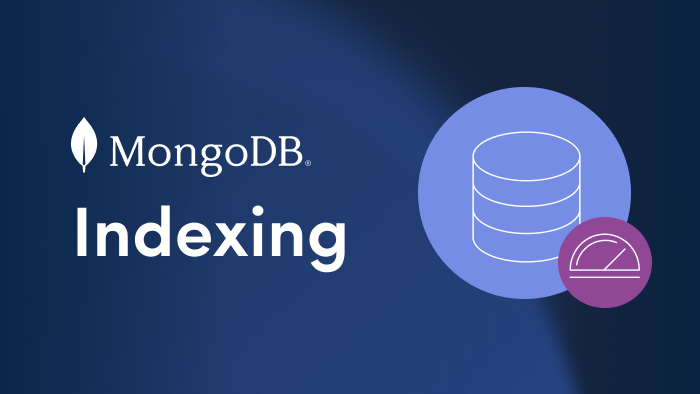MongoDB indexes provide users with an efficient way of querying data. When querying data without indexes, the query will have to search for all the records within a database to find data that match the query.
In MongoDB, querying without indexes is called a collection scan. A collection scan will:
- Result in various performance bottlenecks
- Significantly slow down your application
Fortunately, using MongoDB indexes fixes both these issues. By limiting the number of documents to be queried, you’ll improve the overall performance of the application.
In this tutorial, I’ll walk you through different types of indexes and show you how to create, find and manage indexes in MongoDB.
(This article is part of our MongoDB Guide. Use the right-hand menu to navigate.)
What are indexes in MongoDB?
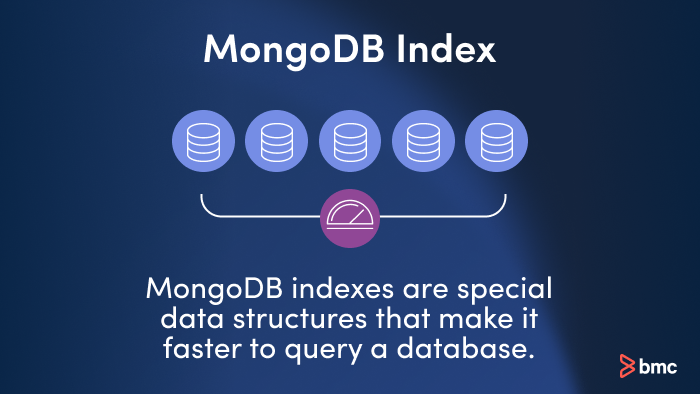
MongoDB indexes are special data structures that make it faster to query a database. They speed up finding and retrieving data by storing a small part of the dataset in an efficient way — you don’t have to scan every document in a data collection.
MongoDB indexes store the values of the indexed fields outside of the data collection and keep track of their location in the disk. The indexed fields are ordered by the values. That makes it easy to perform equality matches and to make range-based queries efficiently. You can define MongoDB indexes on the collection level, as indexes on any field or subfield in a collection are supported.
You can manage the indexes on your data collections by using either the Atlas CLI or the Atlas UI. Both make query execution more efficient.
Why do we need indexes in MongoDB?
Indexes are invaluable in MongoDB. They are an efficient way to organize information in a collection and they speed up queries, returning relevant results more quickly. By using an index to group, sort, and retrieve data, you save considerable time. Your database engine no longer needs to sift through each record to find matches.
What are the disadvantages of indexing?
Indexing does have some drawbacks. Performance on writes is affected by each index you create, and each one takes up disk space. To avoid collection bloat and slow writes, create only indexes that are truly necessary.
How many indexes can you use?
MongoDB indexes are capped at 64 per data collection. In a compound index, you can only have 32 fields. The $text query requires a special text index — you can’t combine it with another query operator requiring a different type of special index.
Working with indexes
For this tutorial, we’ll use the following data set to demonstrate the indexing functionality of MongoDB:
use students
db.createCollection("studentgrades")
db.studentgrades.insertMany(
[
{name: "Barry", subject: "Maths", score: 92},
{name: "Kent", subject: "Physics", score: 87},
{name: "Harry", subject: "Maths", score: 99, notes: "Exceptional Performance"},
{name: "Alex", subject: "Literature", score: 78},
{name: "Tom", subject: "History", score: 65, notes: "Adequate"}
]
)
db.studentgrades.find({},{_id:0})
Result

Are MongoDB indexes unique?
When creating documents in a collection, MongoDB creates a unique index using the _id field. MongoDB refers to this as the Default _id Index. This default index cannot be dropped from the collection.
When querying the test data set, you can see the _id field which will be utilized as the default index:
db.studentgrades.find().pretty()
Result:
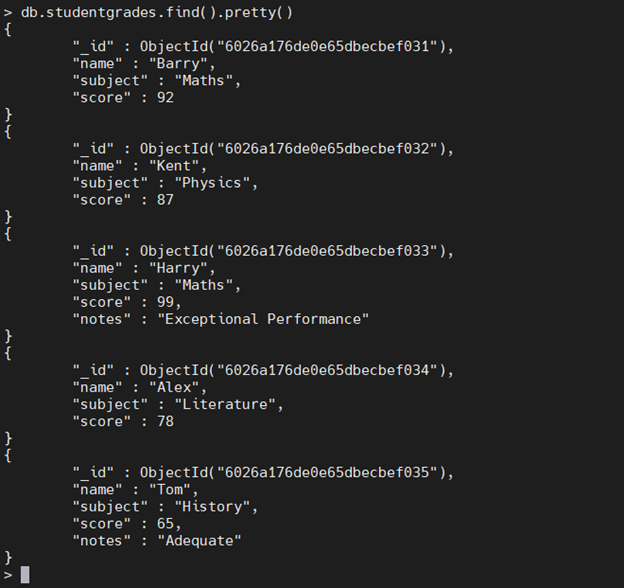
How to create an index in MongoDB
To create an index in MongoDB, use the createIndex()method using the following syntax:
db.<collection>.createIndex(<Key and Index Type>, <Options>)
When creating an index, define the field to be indexed and the direction of the key (1 or -1) to indicate ascending or descending order.
If you use a descending single-field index, it can reduce performance. It is better to use ascending single-field indexes instead, if you want optimal results.
Another thing to keep in mind is the index names. By default, MongoDB will generate index names by concatenating the indexed keys with the direction of each key in the index using an underscore as the separator. For example: {name: 1} will be created as name_1.
The best practice is to use the name option to define a custom index name when creating an index. Indexes cannot be renamed after creation. The only way to rename an index is to first drop that index, which we show below, and recreate it using the desired name.
createIndex() example
Let’s create an index using the name field in the studentgrades collection and name it as student name index.
db.studentgrades.createIndex(
{name: 1},
{name: "student name index"}
)
Result:
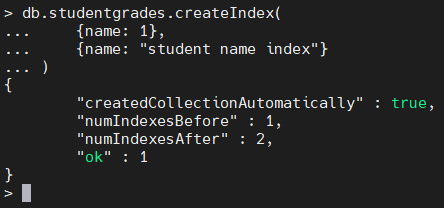
Finding indexes in MongoDB
You can find all the available indexes in a MongoDB collection by using the getIndexes() method. This will return all the indexes in a specific collection.
db.<collection>.getIndexes()
getIndexes() example
Let’s view all the indexes in the studentgrades collection using the following command:
db.studentgrades.getIndexes()
Result:
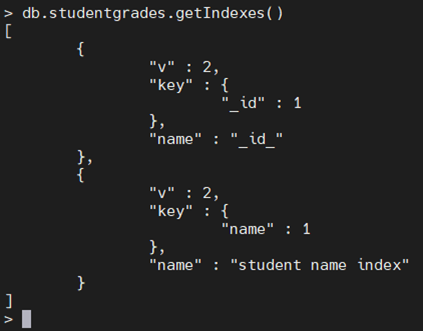
The output contains the default _id index and the user-created index student name index.
How to list indexes in MongoDB
You can list indexes on a data collection using Shell or Compass. This command will give you an array of index documents:
db.collection.getIndexes()
An alternative is to use MongoDB Atlas UI. Open a cluster and go to the Collections tab. Select the database and collection, then click on Indexes to see them listed.
Lastly, you can use the following command in MongoDB Atlas CLI to see the indexes:
atlas clusters index list --clusterName <your-cluster> --db <database> --collection <collection>
How to delete indexes in MongoDB
To drop or delete an index from a MongoDB collection, use the dropIndex() method while specifying the index name to be dropped.
db.<collection>.dropIndex(<Index Name / Field Name>)
dropIndex() examples
Let’s remove the user-created index with the index name student name index, as shown below.
db.studentgrades.dropIndex("student name index")
Result:

You can also use the index field value for removing an index without a defined name:
db.studentgrades.dropIndex({name:1})
Result:

The dropIndexes command can also drop all the indexes excluding the default _id index.
db.studentgrades.dropIndexes()
Result:

What are the different types of indexes in MongoDB?
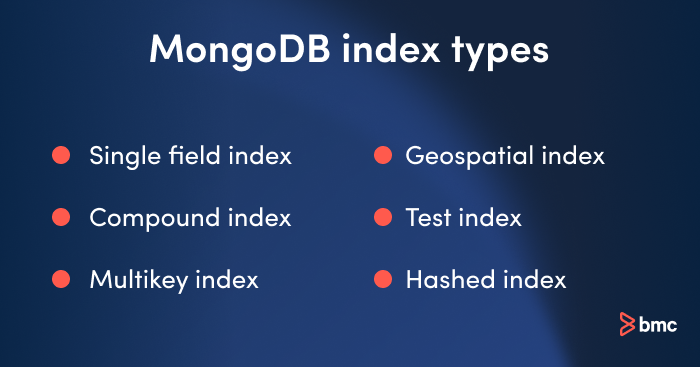
MongoDB provides different types of indexes that can be utilized according to user needs. Here are the main index types in MongoDB:
- Single field index
- Compound index
- Multikey index
In addition to the popular Index types mentioned above, MongoDB also offers some special index types for targeted use cases:
- Geospatial index
- Test index
- Hashed index
Single field index
These user-defined indexes use a single field in a document to create an index in an ascending or descending sort order (1 or -1). In a single field index, the sort order of the index key does not have an impact because MongoDB can traverse the index in either direction.
Example
db.studentgrades.createIndex({name: 1})
Result:

The above index will sort the data in ascending order using the name field. You can use the sort() method to see how the data will be represented in the index.
db.studentgrades.find({},{_id:0}).sort({name:1})
Result:

Compound index
You can use multiple fields in a MongoDB document to create a compound index. This type of index will use the first field for the initial sort and then sort by the preceding fields.
Example
In the following compound index, MongoDB will:
- First sort by the subject field
- Then, within each subject value, sort by grade
db.studentgrades.createIndex({subject: 1, score: -1})

The index would create a data structure similar to the following:
db.studentgrades.find({},{_id:0}).sort({subject:1, score:-1})
Result:

Multikey index
MongoDB supports indexing array fields. When you create an index for a field containing an array, MongoDB will create separate index entries for every element in the array. These multikey indexes enable users to query documents using the elements within the array.
MongoDB will automatically create a multikey index when encountered with an array field without requiring the user to explicitly define the multikey type.
Example
Let’s create a new data set containing an array field to demonstrate the creation of a multikey index in MongoDB.
db.createCollection("studentperformance")
db.studentperformance.insertMany(
[
{name: "Barry", school: "ABC Academy", grades: [85, 75, 90, 99] },
{name: "Kent", school: "FX High School", grades: [74, 66, 45, 67]},
{name: "Alex", school: "XYZ High", grades: [80, 78, 71, 89]},
]
)
db.studentperformance.find({},{_id:0}).pretty()
Result:
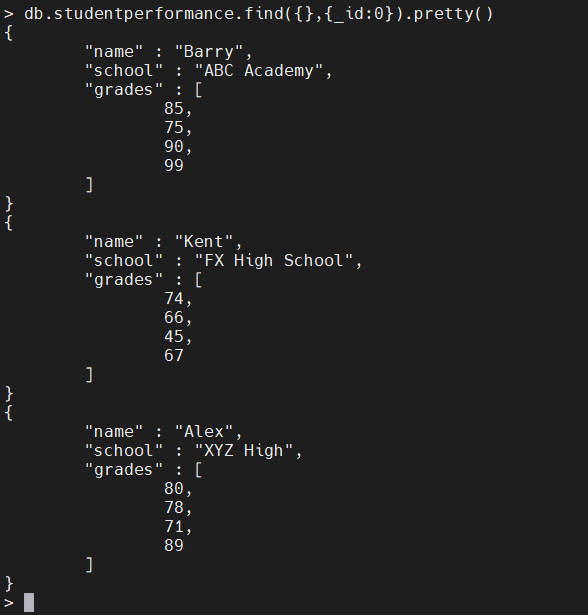
Now let’s create an index using the grades field.
db.studentperformance.createIndex({grades:1})
Result:

The above code will automatically create a Multikey index in MongoDB. When you query for a document using the array field (grades), MongoDB will search for the first element of the array defined in the find() method and then search for the whole matching query.
For instance, let’s consider the following find query:
db.studentperformance.find({grades: [80, 78, 71, 89]}, {_id: 0})
Initially, MongoDB will use the multikey index for searching documents where the grades array contains the first element (80) in any position. Then, within those selected documents, the documents with all the matching elements will be selected.

Geospatial Index
MongoDB provides two types of indexes to increase the efficiency of database queries when dealing with geospatial coordinate data:
- 2d indexes that use planar geometry which is intended for legacy coordinate pairs used in MongoDB 2.2 and earlier.
- 2dsphere indexes that use spherical geometry.
Syntax:
db.<collection>.createIndex( { <location Field> : "2dsphere" } )
Text index
The text index type enables you to search the string content in a collection.
Syntax:
db.<collection>.createIndex( { <Index Field>: "text" } )
Hashed index
MongoDB Hashed index type is used to provide support for hash-based sharding functionality. This would index the hash value of the specified field.
Syntax:
db.<collection>.createIndex( { <Index Field> : "hashed" } )
MongoDB index properties
You can enhance the functionality of an index further by utilizing index properties. In this section, you will get to know these commonly used index properties:
- Sparse index property
- Partial index property
- Unique index property
Sparse index property
The MongoDB sparse property allows indexes to omit indexing documents in a collection if the indexed field is unavailable in a document and create an index containing only the documents which contain the indexed field.
Example
db.studentgrades.createIndex({notes:1},{sparse: true})
Result:

In the previous studentgrades collection, if you create an index using the notes field, it will index only two documents as the notes field is present only in two documents.
Partial index property
The partial index functionality allows users to create indexes that match a certain filter condition. Partial indexes use the partialFilterExpression option to specify the filter condition.
Example
db.studentgrades.createIndex(
{name:1},
{partialFilterExpression: {score: { $gte: 90}}}
)
Result:
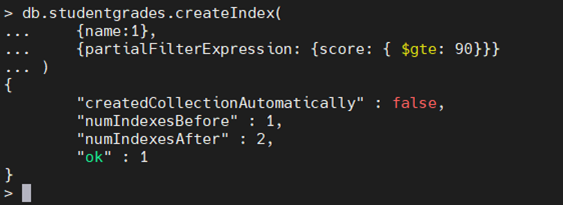
The above code will create an index for the name field but will only include documents in which the value of the score field is greater than or equal to 90.
Unique index property
The unique property enables users to create a MongoDB index that only includes unique values. This will:
- Reject any duplicate values in the indexed field
- Limit the index to documents containing unique values
Example
db.studentgrades.createIndex({name:1},{unique: true})
Result:

The above-created index will limit the indexing to documents with unique values in the name field.
Indexes recap
That concludes this MongoDB indexes tutorial and guide. You learned how to create, find, and drop indexes, use different index types, and create complex indexes. These indexes can then be used to further enhance the functionality of the MongoDB databases, increasing the performance of applications which utilize fast database queries.
Related reading
- BMC Machine Learning & Big Data Blog
- MongoDB Guide, a series of articles and tutorials
- MongoDB: The Mongo Shell & Basic Commands
- Data Storage Explained: Data Lake vs Warehouse vs Database
These postings are my own and do not necessarily represent BMC's position, strategies, or opinion.
See an error or have a suggestion? Please let us know by emailing blogs@bmc.com.
